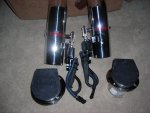45Auto
Commander
- Joined
- May 31, 2002
- Messages
- 2,842
Re: Thru Hull Exhaust
Everything that I have seen says that thru-hulls won't make any difference (except noise!) on a small block unless you're running something pretty radical at higher than normal RPM. Big blocks seem to be a little different case. According to Mercury, it appears that with an exhaust bellows, at high RPM the big blocks can dump enough exhaust gases through the prop to create a vacuum that will slow you down.
From the Mercruiser Gasoline Installation Manual, 90-863021020, May 2002, page 41 (496 HO, 425 HP):
Quote:
Everything that I have seen says that thru-hulls won't make any difference (except noise!) on a small block unless you're running something pretty radical at higher than normal RPM. Big blocks seem to be a little different case. According to Mercury, it appears that with an exhaust bellows, at high RPM the big blocks can dump enough exhaust gases through the prop to create a vacuum that will slow you down.
From the Mercruiser Gasoline Installation Manual, 90-863021020, May 2002, page 41 (496 HO, 425 HP):
Quote:
MAGNUM BRAVO MODEL EXHAUST RECOMMENDATION
Important: To get maximum performance from Magnum Bravo Models, through the transom exhaust is required. It is recommended that the exhaust bellows on the transom assembly be removed. This is necessary to avoid creating a vacuum at the exhaust outlet in the propellor at higher boat speeds. This vacuum could degrade propellor performance on some boats.
Note: If noise regulations do not allow the use of through the transom exhaust, an exhaust pipe kit (Quicksilver P/N 44266A6) must be installed for the through the prop exhaust. This kit also contains an exhaust tube that is used in place of the exhaust bellows.























